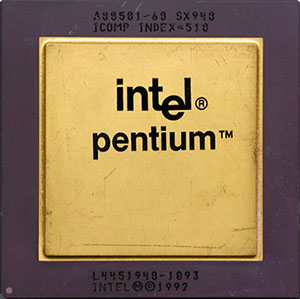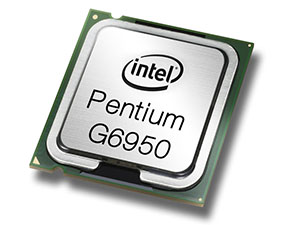Pentium is 20 years old

On this day, exactly 20 years ago, Intel released the Pentium 60 processor, which forever changed the computer industry.
It was based on the P5 architecture (the word “Pentium” is derived from the Greek “penta” - five), contained 3.1 million transistors and was built using an 800nm process. The Pentium 60 used a 5-volt Socket 4 , which was later replaced by a 3.3-volt Socket 5 in the Pentium 75 (which had the same P54C architecture as Xeon Phi - a modern co-processor, one of the top Intel products).
But the Pentium on the road to success had to make a difficult road.
The first versions of processors were not something outstanding. The Pentium 60 worked with a 30 MHz system bus and was hardly faster than 486 competitors. In addition, they were subject to a serious error in the floating point operations module , which Intel did not want to admit for a long time. But still, under pressure from the public, it was forced to replace defective processors. The company, led by Gordon Moore , used this bitter experience to understand what went wrong and improve its internal processes.
')

The market situation drastically changed with the release of the P6 architecture and the Pentium III based on it, which was significantly superior in performance to its competitors.
After P6 came Netburst - an absolute new architecture aimed at increasing the clock frequencies (the Tualatin frequency reached 1.4 Hz, while Prescott reached 3.8 Hz). But this increase was achieved by dubious compromises. The processors were very hot and required powerful and therefore noisy cooling systems. These deficiencies were partially corrected in later revisions - but in the end, this architecture turned out to be a mistake that allowed AMD to win positions with its Athlon and Athlon 64.
During the serious battles between the Pentium 4 and Athlon, the core of the Pentium III peacefully settled in the family of mobile processors Centrino Pentium M (Banias / Dothan), which became a real sensation. In 2007, Intel released Yonah - their dual-core modification.

Then came the era of Core and subsequent processors - Nehalem , Sandy Bridge , Ivy Bridge and the upcoming Haswell . Intel still uses the Pentium brand. But today, he refers to products of the initial price range, often with some trimmed features, such as Hyper-Threading , for example.
Although at the beginning the Pentium was a huge headache for Intel and brought huge financial losses, but ultimately this brand helped the company sell tens of millions of processors and made it the dominant player in the silicon industry.
Happy Birthday, Pentium!
UPD: found a rare Pentium ad from 1994:
Source: https://habr.com/ru/post/173917/
All Articles